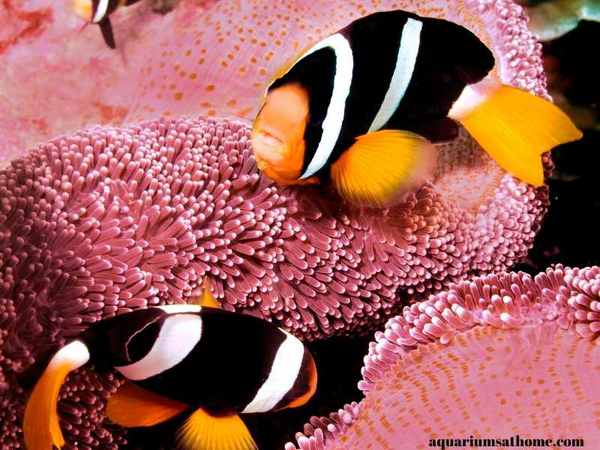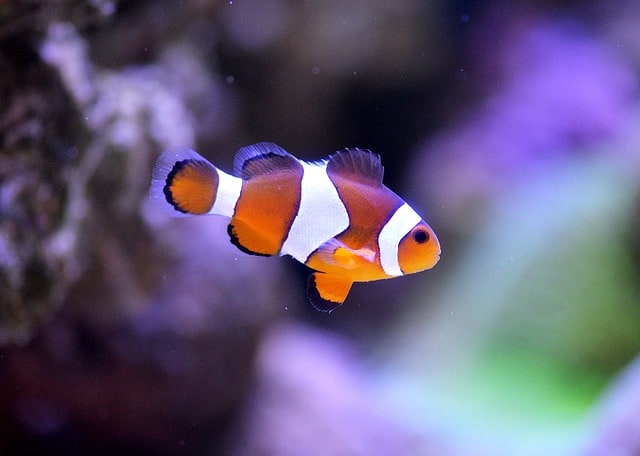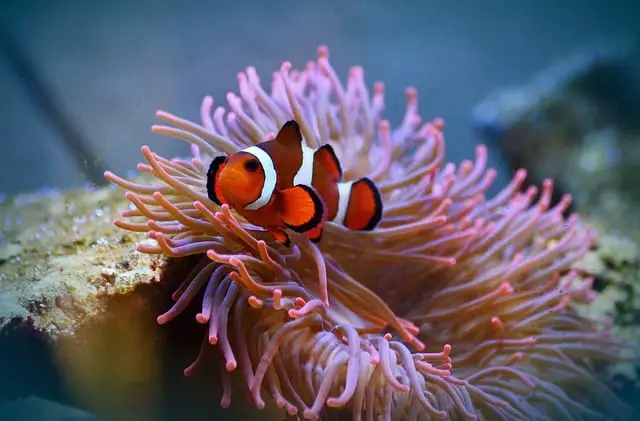Clarkii clownfish (also referred to as Clark’s anemonefish) are a type of saltwater fish found in coastal, coral, and rocky reef around islands in the western Pacific Ocean. Their robust and unique appearance makes them unlike any other species of clownfish. With their black, white, and yellow markings along with their energetic nature, they make a great addition to almost any marine reef tank.
This article will outline all you need to know as an aquarium hobbyist about basic clarkii clownfish care, including how to care for and breed this species in captivity. I’ll explain how big of a tank they need and how to set it up; what water conditions they require; what food to offer them; how long they live; how big they get; what their temperament is like; how they reproduce; and what (if any) diseases they’re prone to. I’ll also discuss some special recommendations for this species as well.
So, if you’re ready to ‘dive deeper’ into the aquatic world of the fascinating and distinctive clarkii clownfish, then let’s begin…
Clarkii Clownfish Overview
Behavior: semi-aggressive
Breeding: egg layer
Care level: intermediate
Diet: omnivore
Family: Pomacentridae
Lifespan: 5 to 10 years
Origin: near coral reefs in the western Pacific
Reef safe: yes
Size: 4 to 5 inches
Tank size: 30-gallon minimum
Clarkii Clownfish Natural Habitat
Clarkii clownfish are found naturally near sheltered coral reefs in the Indo-Pacific. From the Caroline Islands in the east to the Persian Gulf in the west, as far north as the lagoon waters of Southern Japan to the coral seas of New Hebrides in the south. They can dwell at depths of up to 197 feet (deeper than that of any other clownfish species) but seem to prefer warmer, shallow waters in areas rich with live rock and in the presence of anemones.
Clarkii clownfish have made many adaptations to better survive in their natural habitat. For example, they have more rounded caudal fins compared to those of anemonefish. This allows them to make quick, darting movements to escape possible predators. As well, in comparison to other marine fish, they have a highly developed mucus coating that protects them from sea anemone stings.
Clarkii Clownfish Natural Diet
In the wild, clarkii clownfish dine mainly on crustaceans such as amphipods and copepods as well as polychaete worms, coral algae, and whatever’s left from their host anemone’s recent meal. Though omnivores, clarkii clownfish prefer protein-rich foods. They’re voracious eaters and will attack their victims with full force.

Clarkii Clownfish Appearance and Size
Clarkii clownfish vary in color, depending on their region of origin. Typically, their fins are yellow or orange while the rest is black with 3 white stripes running vertically along the body. On some, the tail stripe can be so narrow that they appear to have only 2 white vertical stripes. When full-grown, this species can reach lengths of up to 5 inches, but the average size is closer to 4 inches.
Clarkii Clownfish Behavior and Temperament
Clarkii clownfish tend to be territorial and semi-aggressive in nature, especially once they reach sexual maturity. Considered to be more hostile than ocellaris or percula clownfish, they don’t tolerate others of their kind and do best as a mated pair in a community tank environment. While they don’t require host anemones to survive in captivity, they tend to be calmer in the presence of one.
Clarkii Clownfish Diet (in Captivity)
Clarkii clownfish tend to be aggressive feeders and thrive on a diet of both plant- and meat-based foods. As omnivores, they can be fed a variety of edibles including brine shrimp and bloodworms as well as vegetable flakes and pellets. They’ll even graze upon algae growing naturally in their tank.
To promote vibrancy, try feeding them color-enhancing flake food available online through Amazon.
Clarkii Clownfish Lifespan
Clarkii clownfish can survive anywhere from 3 to 10 years in captivity, though they have been known to live longer when kept as mated pairs in well-established reef tanks with ideal water parameters. In the wild, this species typically lives 13 or more years, especially when hosted by an anemone. To promote longevity, ensure the tank is kept clean and feed them adequately with high-quality, nutrient-rich foods.
Clarkii Clownfish Required Water Parameters
As a type of saltwater/marine fish, clarkii clownfish need very specific tank conditions if they’re to thrive in captivity. The temperature of the aquarium should be between 72- and 82-degrees Fahrenheit with a pH ranging from 7.8 to 8.4. The salinity should be around 1.020 to 1.025. This species doesn’t tolerate fluctuating parameters very well so be sure to test the water frequently to ensure it’s accurate and safe.
Keeping the tank as clean as possible is vitally important to health and longevity of clarkii clownfish. You should do 10-15% partial water changes weekly since prolonged exposure to poor water conditions will typically result in stress or illness. Test the water parameters regularly to ensure toxic chemicals such as ammonia, nitrites, and nitrates are kept at bay.
Clarkii Clownfish Tank Size and Setup
Clarkii clownfish are quite big by aquarium standards and therefore require a medium- to large-sized tank. If you have just a single fish, you can keep it in a 30-gallon aquarium but if you keep a mated pair (which is preferred), then you must invest in a 55-gallon tank. They’ll also need a few hiding places if there’s no anemone and they share their tank with other fish.
Since Clarkii clownfish are found naturally in warm, tropical waters, their aquarium must contain a heater to keep the temperature between 74- and 82-degrees Fahrenheit. An aquarium light is also required along with a filter. Make sure the filter is a low-flow type since clarkii clownfish don’t like a strong current. The best choice is a canister or hang-on-back style, depending on the size of the tank.
Clarkii Clownfish Tank Mates
Clarkii clownfish don’t like the company of other clowns and as a result, should be kept alone or in a mated pair in a community tank. Keeping them with fish of like size and temperament is best. As well, since this species likes to swim in the middle or near the top of the tank, bottom-dwelling fish are a good choice. Saltwater angels, damsels, tangs, blennies, puffers, wrasses, and anemones are recommended.
Note: Don’t keep clarkii clowns with smaller fish – they’ll become territorial and chase after them, especially if the tank is overcrowded. Conversely, don’t keep with them with larger more aggressive fish like groupers or lionfish either.
How to Breed Clarkii Clownfish
Clarkki clownfish are egg layers and considered to be one of the easiest types of marine fish to breed in captivity. The tank should be well-established with a temperature slightly lower than usual – between 79- and 82-degrees is optimal and recommended for good quality eggs. Feeding the mated pair of clarkii clowns a protein-rich diet including frozen mysis and/or brine shrimp will also help encourage breeding.
Clarkki clownfish are unique in that they’re all born male and can spontaneously change sex in the absence of a female. Should two males share an aquarium, the larger of the two will switch gender and for procreation purposes and thus become a mated pair. This hermaphroditic ability allows the species to ensure its survival in captivity.
Types of Clownfish Species
There are many different types of clownfish. The smallest and most peaceful are the ocellaris /false percula and the orange/true percula clowns. Pink skunk clowns and clarkii clowns are medium-sized while maroon and tomato clowns are the largest. Clownfish range in temperament from peaceful to semi-aggressive to aggressive, depending on their size and species.
The most common clownfish is likely the orange or true percula clownfish. The popularity of this species is due mainly to the release of the 2003 Disney/Pixar animated film ‘Finding Nemo.’ This film captured the hearts of moviegoers of all ages and from then-on, clownfish became a much sought-after addition to saltwater reef aquariums.

Other Names for Clarkii Clownfish
Clarkii clownfish are referred to by aquarists as a type of marine ornamental fish and known by other names including: clark’s anemonefish, clark’s clownfish, yellowtail clownfish, black clownfish, chocolate clownfish, brown anemonefish, two-banded anemonefish, and sebae anemonefish. Their scientific name is amphiprion clarkii.
Clarkii Clownfish Cost
Clarkii clownfish can be quite expensive to purchase, depending on where you live. If you reside near the ocean, saltwater fish are more reasonably priced. The farther these fish need to be transported from their place of origin, the more money they end up costing the seller, breeder, or aquarist. On average, this species is valued anywhere from $15 to $40.
Common Clarkii Clownfish Diseases
Like other species of clownfish, clarkia clowns are prone to brooklynella hostilis or ‘clownfish disease.’ This disease is more common with wild caught clownfish versus clownfish that are bred in captivity.
It’s characterized by swollen gills, sloughing of the skin, and labored breathing. This illness is caused by a parasite which can spread easily if not eliminated promptly and properly. The most effective treatment is formalin, a 37% solution of formaldehyde gas dissolved in water with methanol added as a stabilizer.
Begin by quarantining the sick fish in a separate tank with the same water temperature, pH, and salinity as the main tank. A quick ‘dip’ in the formalin solution of higher concentration will start your ill fish on the road to recovery. Continued treatment in a milder formalin solution for a prolonged length of time will work to effectively eradicate the disease.
Special Recommendations for Clarkii Clownfish
Clarkii clownfish, need a clean, stable aquatic environment if they’re to live long, healthy lives in captivity. Their longevity is directly linked to their stress level so if they’re kept in a mated pair in a large, well-established aquarium with peaceful tankmates and an anemone, they’ll thrive. Weekly 10% partial water changes are a must to keep the tank ammonia-free and safe for your clownfish pets.
Furthermore, clarkii clownfish don’t like the company of their own kind so never keep them with other species of clownfish. A single fish or mated pair is all you can have at any given time – 30-gallons for a single clarkii and 60-gallons for a mated pair. As mentioned above, the flourish in the presence of an anemone so adding a bubble tip anemone to the tank is strongly recommended.
Are Clarkii Clownfish Hardy?
In terms of marine fish, clarkii clownfish are known for their hardiness and therefore considered a great choice for beginner saltwater hobbyists. This species, though not tolerant of extreme changes to their aquatic environment, can still thrive in a clean, well-established reef tank with slight fluctuations in water parameters.
Pros and Cons of Clarkii Clownfish
Pros
- clarkii clownfish are beautifully colored and a joy to observe – they display well and their bold, interactive behavior adds ‘life’ to any aquarium
- clarkii clownfish are hardy and easy to care for which makes them ideal for beginner aquarists
- clarkii clownfish are easy to feed and eat readily available online or in-store bought fresh, frozen, or dried fish foods
- clarkii clownfish are easy to breed in captivity
- clarkii clownfish are the perfect choice for a reef tank setup
Cons
- clarkii clownfish can’t be kept with other species of clownfish and may eat their own offspring once the eggs have hatched
- clarkii clownfish can become aggressive and territorial in a community tank environment, especially in the absence of an anemone
- clarkii clownfish need specific water conditions and aren’t tolerant of fluctuating parameters
- clarkii clownfish can be expensive to purchase, depending on where you live
- clarkii clownfish can’t be kept in a nano tank as they’re simply too big
Final Thoughts
In summation, clarkii clownfish (aka Clark’s anemonefish) are a species of saltwater fish originating in the warm, tropical waters of the Pacific coast near coral reefs. Their staunch appearance and unique black, white, and yellow coloring make them a vibrant and interesting addition to just about any marine reef tank environment.
I trust this article has provided you with all the information you need to breed, raise, and maintain happy, healthy clarkii clownfish. Thanks for reading and good luck with your aquarist hobby.
Recommended Posts
Which Clownfish can be Kept Together?
Do Clownfish Like Being Alone?
What Happens if a Female Clownfish Dies?
Can You Have 3 Clownfish in a Tank?
How Do You Tell if Clownfish are Fighting?




